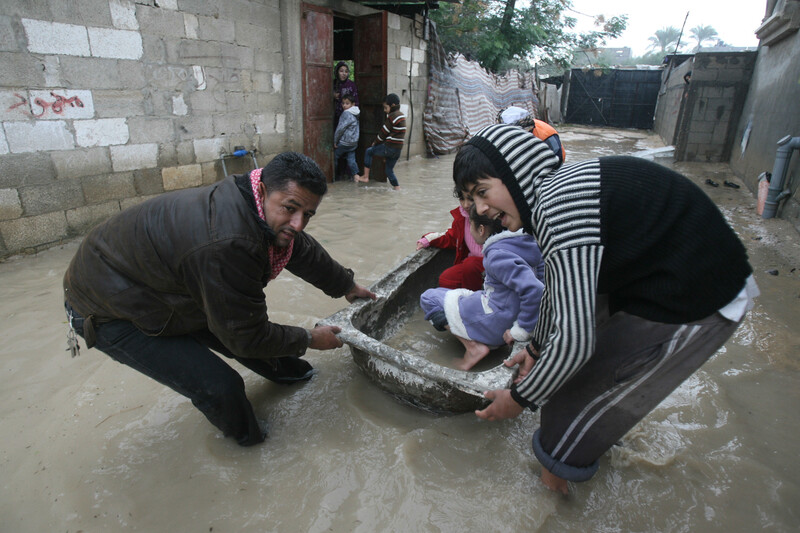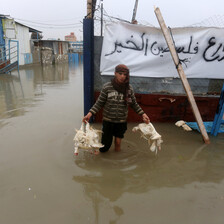The Electronic Intifada Gaza Strip 14 December 2013

Thousands of Palestinians in Gaza have been displaced because of severe flooding.
APA imagesTwo metal sheets fell from the ceiling of Bilal al-Riqib’s house on Tuesday evening, narrowly missing his wife and children. The power had already been cut when the house was struck by one of the worst storms Gaza has encountered in living memory, flooding large areas and displacing thousands of residents.
The destruction led al-Riqib and his family — including his five-month-old baby — to seek shelter at a nearby school, though they now spend nights in a neighbor’s home.
Located in Bani Suhaila, a town in southern Gaza, al-Riqib’s cottage-like home consists of two rooms. Al-Riqib, a 31-year-old unemployed construction worker, pointed to a children’s wardrobe that was wrecked by the storm. He had not yet fully paid for the piece of furniture.
Al-Riqib has not had any income since July, when the Egyptian authorities destroyed numerous underground tunnels linking Egypt to Gaza. His business had depended on construction materials brought into the Strip via the tunnels.
“I have been told by municipality officials here that they would help fix my damaged house, but no one has yet come to repair it, given the fact I am unemployed,” he said. “Some good people of charity are the only ones who have helped me out over the past five months.”
Desperate
Approximately 100 persons from 16 families have taken refuge in the Ibn Zaidoun primary school in Bani Suhaila. Basim Qahwaji, a 46-year-old father, is among them, along with seven of his nine children. Their house has been flooded as a result of heavy rainfall.
“My seven children and their mother are now sleeping in this classroom, without heating, adequate blankets, mattresses or pillows,” he said. “We have been given only three mattresses and three blankets and some food and water.”
His wife, Warda Abu Taima, said: “This is such a desperate a situation that we do not know what to do and how to manage, given that my husband has some problems with his back and is unable to work.”
Mohammad Braim, a local authority official, said it had not yet been decided whether the 16 families should remain at the school or be sent somewhere else before lessons begin on Sunday morning.
“We have done what we can to shelter these families,” Braim added. “We have distributed blankets, food and water. Up to this moment, we have not done any repair work on the damaged houses.”
“Water as far as the eye can see”
The Hamas-led administration in Gaza has estimated that as of Friday, 2,825 persons have been displaced due to what is being described locally as the most severe storm in the Strip since 1952 (“Widespread flooding in Gaza forces thousands to flee homes,” Ma’an News Agency, 13 December).
“Large swathes of northern Gaza are a disaster area with water as far as the eye can see,” Chris Gunness, spokesman for UNRWA, the UN agency for Palestine refugees, told Ma’an News Agency today.
He said hundreds of families had been evacuated from flooded areas to UNRWA facilities and thousands of UNRWA workers had been “working through the night and round the clock to assist the most vulnerable, the old, the sick, children and women.”
Despite these efforts, “the situation is dire and with the flood waters rising, the risk of water borne disease can only increase,” Gunness warned.
The problems caused by the storm have been compounded by a power crisis that has left Gaza without electricity between 12 and 16 hours per day, and sometimes longer, as well as the ongoing siege imposed by Israel.
“Any normal community would struggle to recover from this disaster. But a community that has been subjected to one of the longest blockades in human history, whose public health system has been destroyed and where the risk of disease was already rife, must be freed from these man made constraints to deal with the impact of a natural calamity such as this,” Gunness added.
Gunness renewed his agency’s call for “effective pressure to end the blockade of Gaza” that was exacerbating the crisis caused by the storm.
Surgeries halved
A few days before the storm hit, the World Health Organization reported that there had been a marked deterioration in the availability of medicines and vital services in Gaza.
Large generators for powering hospitals during electricity cuts have been encountering breakdowns. One of two generators at the European Gaza Hospital burned out in November.
WHO also stated that publicly-run hospitals in Gaza have cut non-urgent surgeries by half in recent months in an attempt to keep scarce fuel for emergency procedures.
“Serious disaster”
More than 30 persons were injured during the storm, according to press reports. They included a five-year-old boy, hit by a rock which fell from a roof in the Khan Younis refugee camp in southern Gaza. The boy was rushed to hospital.
“This is a serious disaster,” Isra Almodallal, a Hamas spokesperson, told The Electronic Intifada. “With the lack of fuel and electricity, the government is trying hard to help with limited resources. Unless the borders are reopened and the needed equipment is allowed in, it will be difficult for us to handle this crisis.”
She urged the UN and governments around the world to pressure Israel into lifting its siege.
“Recently, 2014 was declared the year of solidarity with the Palestinian people,” she said. “Therefore, I think it is time for real action to alleviate the suffering of the Palestinian people, especially here in the Gaza Strip.”
Rami Almeghari is a journalist and university lecturer based in the Gaza Strip.




